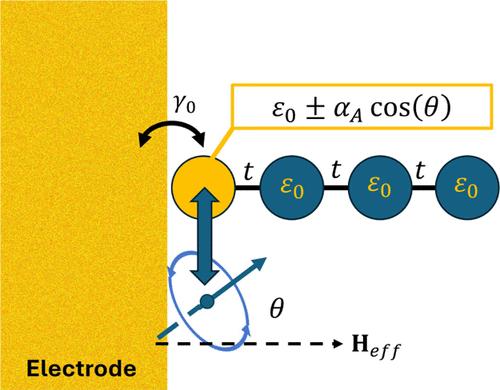当前位置:
X-MOL 学术
›
J. Am. Chem. Soc.
›
论文详情
Our official English website, www.x-mol.net, welcomes your
feedback! (Note: you will need to create a separate account there.)
Surface Magnetic Stabilization and the Photoemission Chiral-Induced Spin-Selectivity Effect
Journal of the American Chemical Society ( IF 14.4 ) Pub Date : 2024-11-13 , DOI: 10.1021/jacs.4c12974 Oliver L. A. Monti, Yonatan Dubi
Journal of the American Chemical Society ( IF 14.4 ) Pub Date : 2024-11-13 , DOI: 10.1021/jacs.4c12974 Oliver L. A. Monti, Yonatan Dubi

|
The spinterface mechanism was suggested as a possible origin for the chirality-induced spin-selectivity (CISS) effect and was used to explain and reproduce, with remarkable accuracy, experimental data from transport experiments showing the CISS effect. Here, we apply the spinterface mechanism to explain the appearance of magnetization at the interface between nonmagnetic metals and chiral molecules, through the stabilization of otherwise fluctuating magnetic moments. We show that the stabilization of surface magnetic moments occurs for a wide range of realistic parameters and is robust against dephasing. Importantly, we show that the direction of the surface magnetic moments is determined by the chiral axis of the chiral molecules. Armed with the concept of stable surface magnetic moments, we then formulated a theory for the photoemission CISS effect. The theory, based on spin-dependent scattering, leads to direct predictions regarding the relation between the photoemission CISS effect, the chiral axis direction, the spinterface “size”, and the tilt angle of the detector with respect to the surface. These predictions are within reach of current experimental capabilities and may shed new light on the origin of the CISS effect.
中文翻译:

表面磁稳定和光电子手性诱导的自旋选择性效应
spinterface 机制被认为是手性诱导的自旋选择性 (CISS) 效应的可能来源,并用于以非常准确的方式解释和再现来自显示 CISS 效应的运输实验数据的实验数据。在这里,我们应用 spinterface 机制来解释非磁性金属和手性分子之间界面处的磁化外观,通过稳定原本波动的磁矩。我们表明,表面磁矩的稳定发生在广泛的实际参数中,并且对移相具有鲁棒性。重要的是,我们表明表面磁矩的方向是由手性分子的手性轴决定的。以稳定表面磁矩的概念为武器,我们随后制定了光电子 CISS 效应理论。该理论基于自旋依赖性散射,可以直接预测光发射 CISS 效应、手性轴方向、spinterface“大小”和探测器相对于表面的倾斜角之间的关系。这些预测在当前的实验能力范围内,可能会为 CISS 效应的起源提供新的启示。
更新日期:2024-11-14
中文翻译:

表面磁稳定和光电子手性诱导的自旋选择性效应
spinterface 机制被认为是手性诱导的自旋选择性 (CISS) 效应的可能来源,并用于以非常准确的方式解释和再现来自显示 CISS 效应的运输实验数据的实验数据。在这里,我们应用 spinterface 机制来解释非磁性金属和手性分子之间界面处的磁化外观,通过稳定原本波动的磁矩。我们表明,表面磁矩的稳定发生在广泛的实际参数中,并且对移相具有鲁棒性。重要的是,我们表明表面磁矩的方向是由手性分子的手性轴决定的。以稳定表面磁矩的概念为武器,我们随后制定了光电子 CISS 效应理论。该理论基于自旋依赖性散射,可以直接预测光发射 CISS 效应、手性轴方向、spinterface“大小”和探测器相对于表面的倾斜角之间的关系。这些预测在当前的实验能力范围内,可能会为 CISS 效应的起源提供新的启示。


















































 京公网安备 11010802027423号
京公网安备 11010802027423号